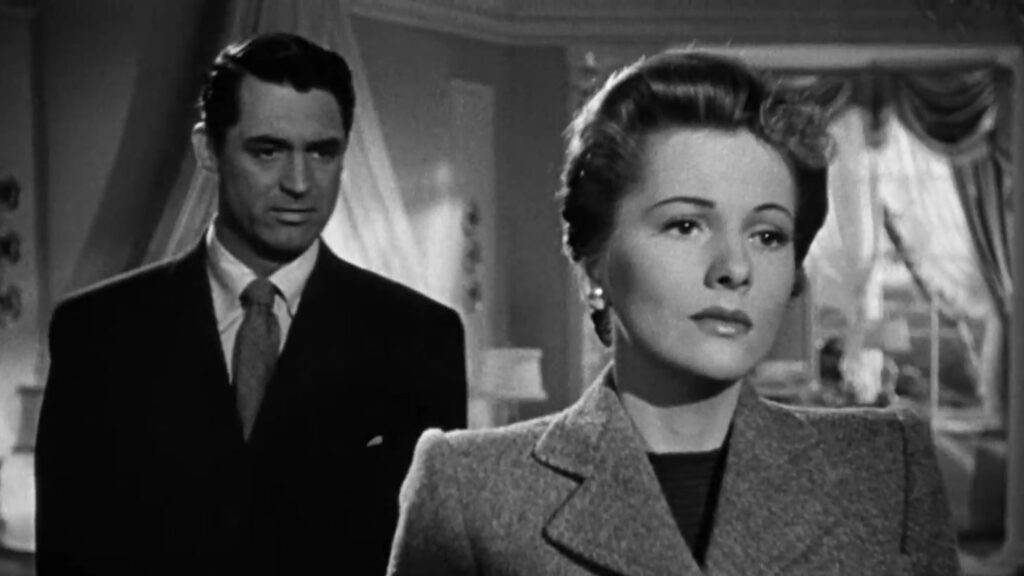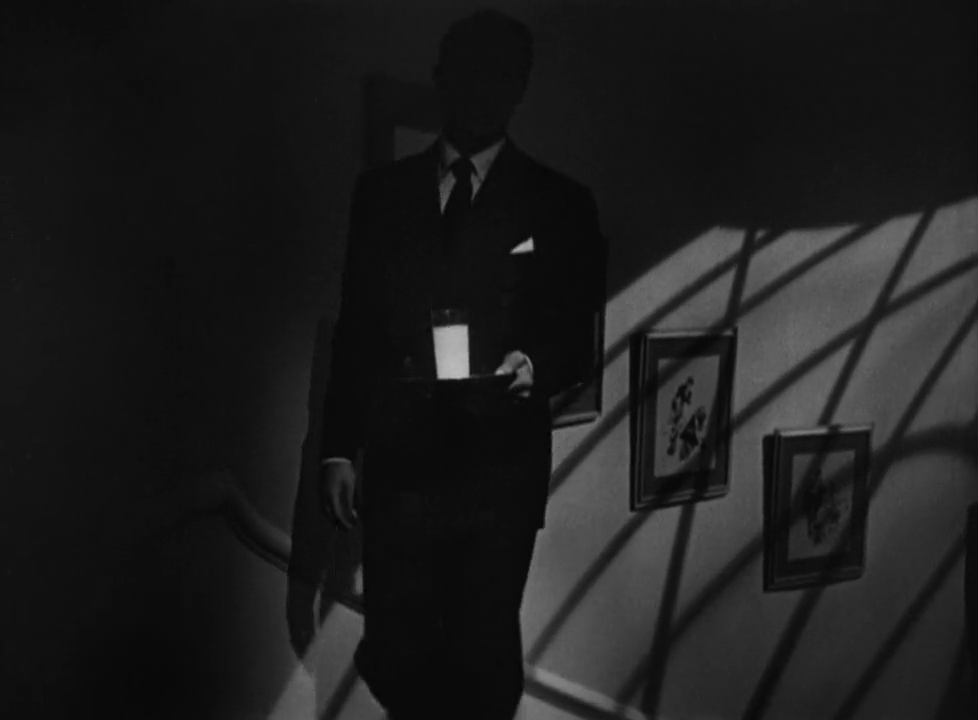Lowkey sus
Suspicion is Hitchcock playing peekaboo. The juiciest stuff keeps happening just out of view, conveyed through rumors and second-hand recounting. Its most powerful images are not violence but the negative space suggesting it: a shadow of a slowly opening door, a glowing glass of milk that may or may not be poisoned. Nineteen years before “psycho” became his brand, Hitch spends the film focused more on internal breakdown than external action: doubts, projections, marital power games. It’s also a hair slower than the director’s usual thriller machinery, but the tension simmers steadily and, when the kettle finally whistles, your nerves are fried.
The setup is a bit gaslighty: Lina McLaidlaw (Joan Fontaine) is a shy, bookish heiress who falls hard for rakish charmer Johnnie Aysgarth (Cary Grant). The pair rush through a whirlwind courtship, an elopement, and a new home perched on a hill. By the time Lina gets a good look around, the bills are piling up and Johnnie is telling stories that don’t add up. Rich friends conveniently die to absolve debts, vanished family heirlooms show up in a pawnshop, get-rich-quick schemes grow increasingly desperate, and the wallpaper in their cozy nest starts to feel more like prison bars. The plot is told almost entirely through Lina’s eyes, and you share her growing distrust of Johnnie.

Hitchcock wrings enormous power in his precise staging of Johnnie. Grant practically materializes into some shots, an apparition whose screen presence feels unnatural. He almost never walks in from stage left or right, instead popping up from behind objects or through doorways. Hitch makes Johnnie more menacing with each passing minute, which scratches at Lina’s paranoia even when Johnnie’s doing something harmless. The house, meanwhile, quietly mutates from domestic paradise to Gothic estate, every landing and banister growing more shadowy. By the time that famous glass of milk ascends the staircase, the lighting is doing as much storytelling as the script.
Fontaine gives the film its pulse. Her expressive face (featuring some tremendous eyebrow work) is a weather vane for suspicion — each new gust of information turns her in a new direction, sometimes toward devotion, sometimes toward horror. It’s a technical and delicate performance that is still messy and human, which is the right flavor for a character who’s constantly changing her mind about which version of her husband she believes in. Grant, meanwhile, plays up his contradictions, with Hitchcock sharpening the actor’s edges: urbane and slippery, flirtatious and faintly predatory, megawatt charming yet always evasive. The film never quite “solves” either character, which gives the film’s final act some real danger and ambiguity. Even what the story suggests in the final few scenes doesn’t always match how Hitch frames the characters nor how Fontaine and Grant play them.
The film has a thick seam of sexual subtext running it. Grant plays with a cool, nontraditional masculinity — debonair, vain, a little frivolous — that brushes up against classical Hollywood’s queer codes without tipping fully that direction. Hitchcock being Hitchcock, he toys with this association between sexual “irregularity” and danger, one of the director’s recurring preoccupations. Fontaine, meanwhile, threads an unsettling Beauty and the Beast attraction-repulsion: you can sense Lina’s arousal wake up around danger even as she feels more alienated by Grant’s inscrutability. The implied bedroom dynamics serve as a battleground of undercurrents.

Formally, the movie is packed with Hitchcock flourishes, particularly the closing act. A couple of shots near the climax carve the space into shadowy geometry bordering on abstract composition. Hitchcock leans on the power of props more than ever: letters, trinkets, chairs, etc. These items and the ways characters use and manipulate them give physical form to the film’s psychological tension.
The film’s biggest problem is that, even with the depth of its scenario and its knack for well-timed pivots, its design is a bit too slow and low-thrills to really soar. The finale is the best stretch, but even it feels a touch compromised and docile, the studio era’s squeamishness tugging against the nastier hints of betrayal and murder the film flirts with. Hitchcock says in his iconic interview Francois Truffaut that he toyed with multiple versions of the last reel, and the one we get is the softest version of the finales he outlined.
Suspicion isn’t quite top-shelf Hitchcock, more B-side than banger, but when a filmography runs 50+ films deep, these are the kind of films you cherish. Suspicion is an absorbing early entry in Hitchcock’s psychology-of-marriage cycle (see also: five-star masterpiece Notorious and nightmare machine Marnie). The craft is wonderful, as always with Hitchcock, and the acting is enigmatic if not as iconic as the director’s best performances of the ‘50s and ‘60s. The suggestion of betrayal in both the script and on the screen is where Suspicion thrives: in the bedroom shadows, in the pause before a calculated accusation, and in the sip of milk you’re not sure you should take.
Is It Good?
Very Good (6/8)
Dan is the founder and head critic of The Goods. Follow Dan on Letterboxd. Join the Discord for updates and discussion.

